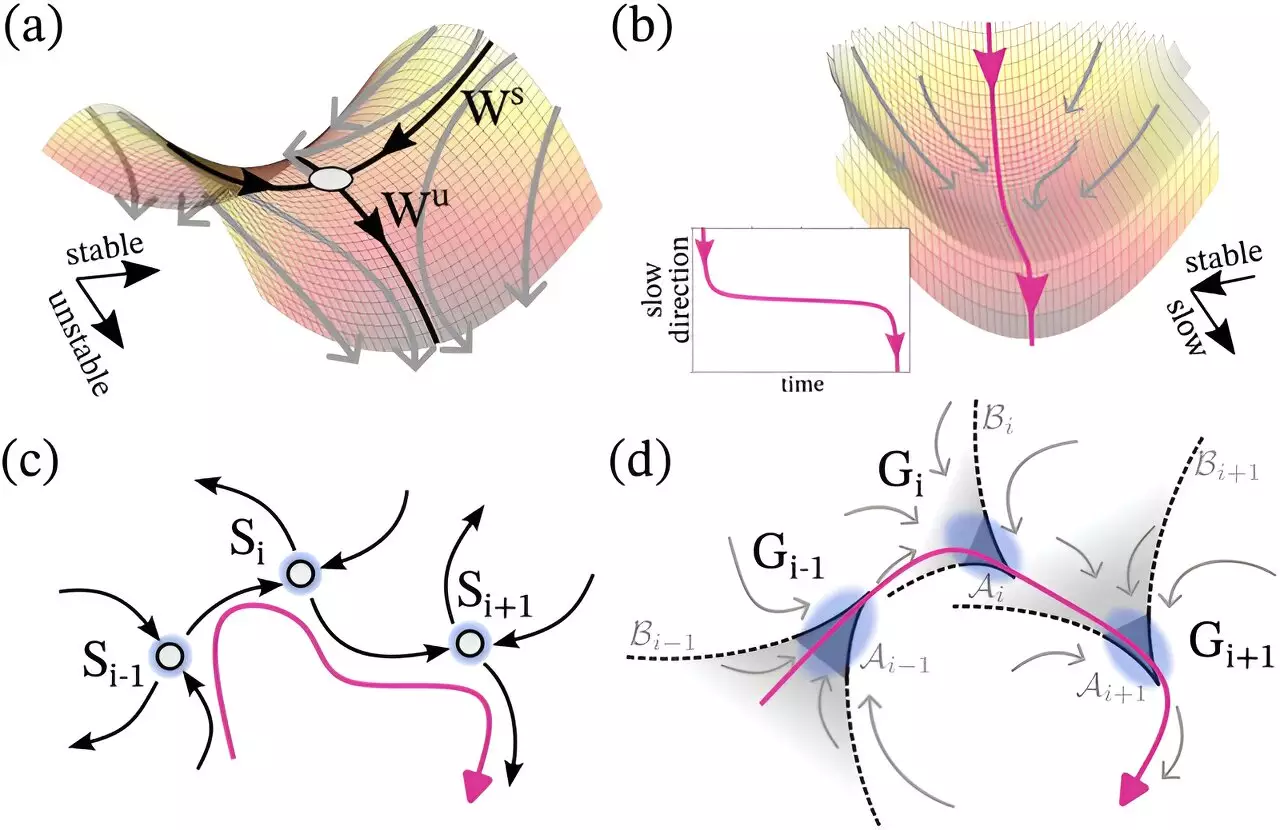In an era where science continuously pushes the boundaries of our understanding, especially in fields like climate change and neurobiology, a groundbreaking mathematical framework has emerged. Researchers have introduced a captivating concept that promises to reshape our comprehension of complex systems: ghost channels and ghost cycles. This innovative approach reveals mechanisms behind long-lasting transient behaviors, which could hold the key to unlocking various natural phenomena.
This framework arises from a collaborative effort among scientists from the Max Planck Institute for Neurobiology of Behavior, the University of Leicester, and King’s College London, recently detailed in the esteemed journal Physical Review Letters. It dares to challenge traditional paradigms that have long dictated our understanding of dynamical systems, specifically the fixation on stable or unstable equilibria. Ghost structures offer a fresh lens through which we can examine phenomena ranging from neuronal dynamics involved in sensory information processing to ecological tipping points that threaten biodiversity.
Transient Stability: A Novel Perspective
To grasp the innovative nature of ghost channels, one must first recognize the limitations of classical models that categorize system states as either stable attractors or unstable ones. These models have been instrumental in explaining behaviors at equilibrium but fall short when applied to real-world dynamics that often exhibit noise and fluctuations. Ghost structures illustrate that systems can, in fact, display transient stability—remaining in a quasi-stable state before transitioning rapidly into another state with vastly different properties.
This phenomenon mirrors how our brains process information while navigating different environments. When taking directions in an unfamiliar area, our cognitive system teeters on the edge of stability, recalling essential details—prioritizing memory before engaging with new inputs. This duality of function is reflected in ecological systems, where species can dominate for extensive periods, only to face sudden disruptions that prompt rapid shifts in ecosystem balance.
Ghost Channels: Bridging the Gap Between Stability and Change
The framework’s most compelling element is the presence of ghost channels and ghost cycles, which serve as conduits for transitioning utilizing unstable structures. Like the metaphorical saddle that stabilizes in one direction but remains precarious in another, these ghost formations highlight critical shifts occurring in complex systems when pushed to the brink of instability. They allow for the exploration of different regimes within a dynamic system, showcasing how one can navigate adversity while retaining the essence of prior structures.
Dr. Akhilesh Nandan from the Max Planck Institute aptly states that redefining the governing dynamics of complex systems from stable states to these unstable structures presents a potential method for deciphering behaviors observed across numerous systems. By constructing a mathematical representation of ghost objects, scientists gain a profound understanding of transient behaviors. The implications extend beyond theoretical realms, paving the way for applied science in ecology and neuroscience.
The Implications for Ecology and Climate Systems
The predictive capabilities granted by this framework are monumental, particularly in critical fields such as ecology and climate science. For instance, coral reefs that present a facade of health may be hiding imminent risks of tipping into degraded states dominated by algae. Traditional predictive models often falter at identifying these dangerous thresholds. By integrating ghost-based frameworks, scientists could significantly improve our ability to forecast such shifts, safeguarding ecosystems against detrimental changes.
Additionally, the implications for understanding climate systems are staggering. Ghost channels may help scientists anticipate changes in phenomena like the Atlantic Meridional Overturning Circulation—one of the key components influencing global climate dynamics. By identifying ghost structures, researchers can explore the interconnectedness of various climate sub-systems, thereby enhancing predictive models and policy-making.
Transforming Biological and Artificial Intelligence Research
Beyond ecological and climate-focused applications, the potential for ghost structures to revolutionize fields such as artificial intelligence and biological research is exhilarating. Initial investigations suggest that these ghost scaffolds could improve learning processes in both biological and machine learning systems by addressing the issues of catastrophic forgetting—a common pitfall in artificial neural networks.
Dr. Aneta Koseska highlights the excitement surrounding these innovative approaches, indicating that they provide an essential framework for learning and adaptation in diverse systems, thus bridging the gap between biological robustness and artificial neural capabilities.
Future Directions: Exploring the Unknown
The advent of this mathematical framework offers scientific inquiry a renewed vigor, inviting researchers to delve deeper into the complexity of transient dynamics across a variety of ecosystems and systems engineered by humans. There exists a treasure trove of possibilities for exploration, allowing scientists to fine-tune our understanding of how entities navigate instability and change.
Ghost channels and cycles represent more than just mathematical curiosities; they embody a revolutionary shift in approaching the complexities of both natural and artificial systems. The promise they hold not only ignites curiosity within the scientific community but potentially establishes a roadmap for addressing longstanding challenges across various domains. As we stand on this frontier, one cannot help but feel an electrifying anticipation for the horizons yet to be explored.

